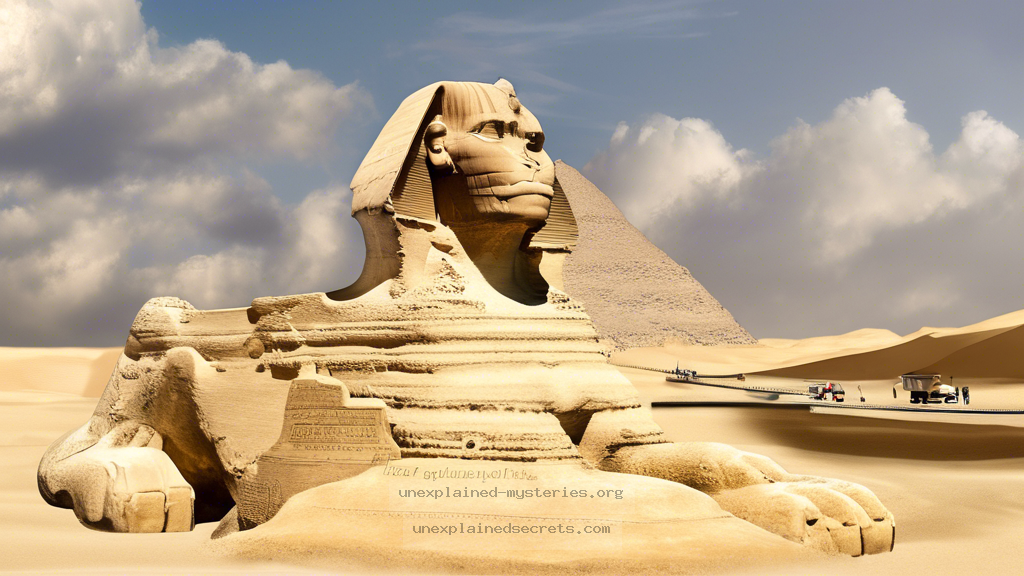What Secrets Lie Beneath the Surface of the Great Sphinx of Giza?
What Secrets Lie Beneath the Surface of the Great Sphinx of Giza?
The Great Sphinx of Giza, a monumental statue with the body of a lion and the head of a pharaoh, has captivated the imaginations of historians, archaeologists, and adventurers alike for centuries. But despite its grandeur and historical significance, many mysteries surround this ancient wonder. Why was the Sphinx built? What secrets does it conceal beneath its surface? This post delves into the enigmatic nature of the Sphinx, exploring its historical context, theories about its purpose, and the controversies that continue to spark interest in this ancient marvel.
Historical Context: The Origins of the Sphinx
The Great Sphinx is believed to have been constructed during the reign of Pharaoh Khafre (c. 2558–2532 BC) of the Fourth Dynasty of the Old Kingdom of Egypt. Carved from a single limestone ridge, the Sphinx measures 66 feet high and 240 feet long, making it one of the largest and oldest statues in the world. Its location near the Pyramids of Giza has led many to believe that it was part of a larger complex of tombs and temples designed to honor the deceased pharaohs.
However, the precise purpose of the Sphinx remains a subject of debate. Some scholars argue that it was built as a guardian of the Giza Plateau, while others suggest that it served as a representation of Khafre himself, embodying the pharaoh’s power and divine status. The Sphinx’s face is strikingly similar to Khafre’s visage, leading many to believe that it was intended to immortalize the pharaoh’s likeness.
Core Concepts: What Lies Beneath the Sphinx?
One of the most intriguing aspects of the Great Sphinx is the speculation about what lies beneath it. In the 1990s, a series of geological surveys and studies conducted by various researchers raised the possibility of hidden chambers beneath the Sphinx. In 1991, Dr. Zahi Hawass, then head of Egypt’s Supreme Council of Antiquities, announced that a team of geologists had discovered anomalies in the ground beneath the Sphinx, suggesting the presence of cavities or tunnels.
In 2015, a more detailed investigation led by the French archaeologist Dr. Gilles Dormion utilized ground-penetrating radar (GPR) technology, which revealed several anomalies that may indicate the presence of tunnels or chambers. The findings have fueled speculation about whether the Sphinx may hold ancient artifacts, texts, or even the lost knowledge of the ancient Egyptians. The prospect of undiscovered chambers beneath the Sphinx raises questions about the potential for new archaeological discoveries that could reshape our understanding of ancient Egyptian civilization.
Practical Implications: Evidence and Investigation
The investigation into the Sphinx’s subterranean structure has practical implications for archaeology and the preservation of ancient sites. If chambers or tunnels are indeed found, it would not only provide insights into the construction and purpose of the Sphinx but also pose challenges for the preservation of the site. Excavation could risk damaging this iconic monument, a concern that has led to a cautious approach from archaeologists.
Moreover, the technological advancements in non-invasive methods such as GPR and electromagnetic surveys are revolutionizing the way archaeologists explore ancient sites. These methods allow researchers to visualize subsurface structures without the need for invasive digging, minimizing the risk to the integrity of historical sites.
Alternative Perspectives: Theories on the Sphinx’s Purpose
While many theories suggest that the Sphinx was a guardian of the Giza Plateau or a representation of Khafre, alternative perspectives challenge these interpretations. Some researchers propose that the Sphinx predates the pyramids, potentially dating back to an earlier civilization. This theory, known as the “Sphinx Water Erosion Hypothesis,” posits that the erosion patterns on the Sphinx indicate it was subjected to heavy rainfall, suggesting a much older origin than previously thought.
This hypothesis has been a topic of heated debate among scholars. Proponents argue that the geological evidence supports their claims, while skeptics assert that the erosion can be attributed to wind and sand rather than water. If proven true, this theory could dramatically alter our understanding of ancient Egyptian history and the timeline of civilization in the region.
Common Misconceptions: Debunking Myths About the Sphinx
The Great Sphinx has been the subject of numerous myths and misconceptions over the years. One common myth is that the Sphinx originally had a nose that was deliberately destroyed by iconoclasts. In reality, the nose is believed to have eroded over time due to natural weathering and vandalism, as evidenced by historical texts and images from various periods.
💡 Notable Fact: The Sphinx was originally painted in bright colors, a detail often overlooked in popular depictions. Ancient Egyptians may have adorned the Sphinx with a vibrant palette, adding to its majestic appearance.
Another misconception is that the Sphinx served as a tomb for Khafre. While the Sphinx is located near the pyramids, there is no concrete evidence to suggest that it functioned as a burial site. Instead, it is believed to have served as a symbol of royal power, possibly linked to the pharaoh’s journey in the afterlife.
Best Practices for Investigating Ancient Mysteries
Investigating ancient mysteries like the Sphinx requires a multidisciplinary approach that combines archaeology, geology, and technology. Here are some best practices for researchers:
- Utilize Non-Invasive Technologies: Employing ground-penetrating radar, drone surveys, and other non-invasive methods can help uncover hidden structures without causing damage.
- Collaboration Across Disciplines: Engaging experts from various fields, including historians, archaeologists, and geologists, can provide a more comprehensive understanding of the site.
- Preservation First: Prioritize the preservation of ancient sites over excavation. Minimizing human impact is crucial for maintaining the integrity of historical monuments.
- Public Engagement: Involve the local community and the public in archaeological efforts to foster appreciation and understanding of cultural heritage.
Future Developments: Ongoing Research and Exploration
As technology continues to advance, ongoing research into the Great Sphinx promises to shed new light on its mysteries. The use of advanced imaging techniques and artificial intelligence to analyze large datasets may uncover patterns and insights previously unattainable. Collaborations between international research teams are also likely to enhance our understanding of the Sphinx and its place within ancient Egyptian civilization.
Moreover, as global interest in ancient mysteries grows, funding and resources for archaeological research are expected to increase. This could lead to more extensive excavations and studies, bringing us closer to uncovering the secrets hidden beneath the Sphinx.
Conclusion: The Enduring Enigma of the Great Sphinx
The Great Sphinx of Giza remains one of the most iconic and enigmatic monuments of ancient Egypt. While much has been learned about its historical context and possible purposes, many questions remain unanswered. The potential for hidden chambers and artifacts continues to inspire new generations of researchers and enthusiasts alike.
As we peel back the layers of history, the Sphinx stands as a testament to the ingenuity of the ancient Egyptians and the mysteries that still await discovery. Whether as a guardian of the past or a monument to a powerful pharaoh, the Sphinx endures as a symbol of the quest for knowledge and understanding in our exploration of ancient mysteries. ✅
Other Articles
Recent Posts
- What Happened to Flight MH370? The Conspiracy Theories That Still Haunt Us
- What Secrets Lurk Within the Walls of the Infamous Trans-Allegheny Lunatic Asylum?
- What Evidence Supports the Existence of Bigfoot in the Pacific Northwest?
- What Happened to the Indus Valley Civilization? Unraveling the Mysteries of Ancient Urban Life
- Can Telepathy Be Scientifically Proven Through Laboratory Evidence?







